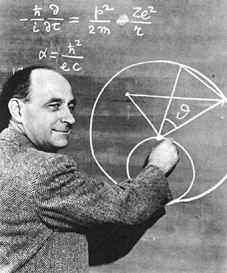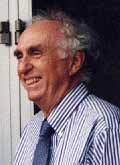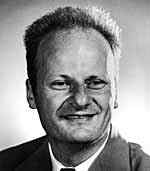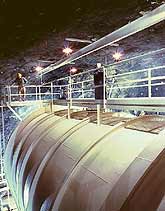![]()
![]()
 Because the energies of atomic and nuclear processes are quantized, the energies of α and γ rays are unique to each radioactive isotope and thus can be used as identifying characteristic properties. But in 1927 it was noted that β rays are emitted from elements such as Bismuth-210 with a continuous spectra of energies. But it was not certain that these electrons are of atomic or nuclear origin, or whether energy is conserved in all cases inside atoms. Progress was made (and the Law of Conservation of Energy saved) in letters (Read one of his letters.) and private conversations in 1930 when Wolfgang Pauli (1900-1958, 1929 photo to left) realized that if β decay produced a hidden, additional (third) product rather than two, only the sum of their energies needed to be quantized. Enrico Fermi (1901-1954, later photo below right) worked out the details of β decay in 1933. Fermi included what he called a neutrino, a little neutral particle that would elude detection because of its neutral charge and tiny or no mass, yet still carry away significant but variable amounts of the energy. The neutrino did preserve the convictions that mass/energy is always conserved and that energies are quantized in atomic and nuclear processes. As a result, the neutrino received immediate acceptance despite having never been actually observed and having properties which made discovery doubtful.
Because the energies of atomic and nuclear processes are quantized, the energies of α and γ rays are unique to each radioactive isotope and thus can be used as identifying characteristic properties. But in 1927 it was noted that β rays are emitted from elements such as Bismuth-210 with a continuous spectra of energies. But it was not certain that these electrons are of atomic or nuclear origin, or whether energy is conserved in all cases inside atoms. Progress was made (and the Law of Conservation of Energy saved) in letters (Read one of his letters.) and private conversations in 1930 when Wolfgang Pauli (1900-1958, 1929 photo to left) realized that if β decay produced a hidden, additional (third) product rather than two, only the sum of their energies needed to be quantized. Enrico Fermi (1901-1954, later photo below right) worked out the details of β decay in 1933. Fermi included what he called a neutrino, a little neutral particle that would elude detection because of its neutral charge and tiny or no mass, yet still carry away significant but variable amounts of the energy. The neutrino did preserve the convictions that mass/energy is always conserved and that energies are quantized in atomic and nuclear processes. As a result, the neutrino received immediate acceptance despite having never been actually observed and having properties which made discovery doubtful.
 While Pauli has speculated that the missing particle might be as massive as an electron, Fermi's neutrino was suspected to be massless. In a typical β decay
While Pauli has speculated that the missing particle might be as massive as an electron, Fermi's neutrino was suspected to be massless. In a typical β decay
the actual particle produced would be an anti-neutrino, νe. (Usual notation places a bar OVER an anti-particle's symbol.) The reverse process was expected to be so unlikely that a typical neutrino, νe, on average would pass through 50 light-years of Lead before being absorbed. Hans Bethe and Rudolph Peierls suggested in 1934 that ...this implies that one evidently will never be able to detect neutrinos.
But years later it was realized that near an intense source of neutrinos such as a large nuclear reactor which due to long operation had built up large amounts of β emitting waste products, a ten ton detector would be just barely adequate to detect enough reactions to conform the neutrino's existence by the reaction
Clyde Cowan (1919-1974) and Frederick Reines (1918-1998) of Los Alamos Laboratory made the first tentative observations of neutrinos in early 1953 using a large reactor at Hanford then observed about one reaction every 20 minutes in 1956 using a new reactor at Savannah River. (Reines was awarded the Nobel Prize in Physics in 1995. Cowan did not receive a Nobel having died earlier.) Later, in a gold mine deep under South Africa, Reines was the first to detect neutrinos created by cosmic rays in the upper atmosphere. He was also part of a joint effort which first detected neutrinos created during a supernova: Supernova 1987A.
| Fermions | Bosons | |||||||||||
|---|---|---|---|---|---|---|---|---|---|---|---|---|
| symbol | Lepton | mass | charge | symbol | Baryon | mass | charge | symbol | mass | |||
| νe | neutrino | ~0 | 0 | n | neutron | 938 Mev | 0 | γ | photon | 0 | ||
| e | electron | 0.5 Mev | - | p+ | proton | 938 Mev | + | π | pi meson | 140 Mev | ||
In a 1937 search for the exchange particle for the nuclear force predicted by Hideki Yukawa (now called the π meson), a team of Neddermeyer and Anderson, and another of Street and Stevenson discovered in cosmic ray collisions a particle with the expected mass of about 200 times that of electrons. But more complete study found this new particle did not combine with matter as anticipated, but rather decayed (changed) to electrons. Instead of finding the predicted exchange particle, they had discovered a totally unexpected particle which became known as the muon, μ, (then short for mu-meson). The muon along with electrons and neutrinos fit a category called leptons. This group contrasted with another group called baryons composed of protons and neutrons. Together they accounted all the know conserved particles called fermions. These fermions have intrinsic angular momenta (spin) of odd-half-integers (1/2, 3/2, ...) which forbids them from co-occupying space with an identical particle according to Pauli's exclusion principle. The search had been for a boson, an integer-spin particle/wave which is not conserved and which is permitted to share space. Exchange of odd spin bosons mediate repulsive forces while exchange of even spin bosons mediate attractive forces.
Missing energy again suggested that neutrinos were also involved in the decay of muons, just like with electrons. About 1961 Leon Lederman, Melvin Schwartz and Jack Steinberger were working to create an intense neutrino beam to learn more about the relationship between neutrinos, electrons, and muons. They used the Brookhaven Alternating Gradient Synchrotron to accelerate protons to an energy of 15 GeV (1 GeV = 109 eV). The intense proton beam collided with a target of Beryllium to produced mainly pi-mesons. These π decayed forming a beam of muons and neutrinos. A 13.5 m thick layer of scrap steel absorbed all but the neutrinos, allowing the team to study what was rarely formed from the neutrinos which had been co-created with the muons. They found that these neutrinos which had been co-created with muons only caused the formation of muons and never electrons. They concluded there must be two kinds of neutrinos: one pairs with electrons and the other pairs with muons.
 Beginning in 1963 Martin Perl (1927- , photo at right) at the Stanford Linear Accelerator Center (SLAC) pondered why the μ was heavier than the electron, if there were other differences, and if there could be additional, more massive leptons. Between 1974 and 1977 he gathered data from head-on collisions between electrons and positrons discovering a third lepton family called tau, τ, a particle with a mass 3500 times that of the electron, which is accompanied by its own neutrino. (Perl was awarded the 1995 Nobel Prize for Physics along with Reines.)
Beginning in 1963 Martin Perl (1927- , photo at right) at the Stanford Linear Accelerator Center (SLAC) pondered why the μ was heavier than the electron, if there were other differences, and if there could be additional, more massive leptons. Between 1974 and 1977 he gathered data from head-on collisions between electrons and positrons discovering a third lepton family called tau, τ, a particle with a mass 3500 times that of the electron, which is accompanied by its own neutrino. (Perl was awarded the 1995 Nobel Prize for Physics along with Reines.)
 Hans Bethe (1906-2005, photo to left) determined in 1938 that the most likely nuclear processes powering the Sun are
Hans Bethe (1906-2005, photo to left) determined in 1938 that the most likely nuclear processes powering the Sun are
For determining the reactions of the Sun, finding that brighter stars use a separate carbon-nitrogen cycle, as well as his work on nuclear reactions in general, Bethe was awarded the 1967 Nobel Prize for Physics. Bethe's solar reactions led to a confirming search for neutrinos from the sun. Surprising findings from that search are described in the postscript below.
 Neutrinos rarely reaction with matter. So to detect reactions caused by the neutrinos, large detectors need to be located in situations where every other type of reaction has been eliminated. To detect neutrinos created in the Sun, a large tank containing 615 tons of C2Cl4 cleaning fluid 1400 m deep in a Gold mine at Lead, South Dakota (at right). While the Chlorine could not detect the most plentiful low energy neutrinos from the Sun, it was expected to detect by
Neutrinos rarely reaction with matter. So to detect reactions caused by the neutrinos, large detectors need to be located in situations where every other type of reaction has been eliminated. To detect neutrinos created in the Sun, a large tank containing 615 tons of C2Cl4 cleaning fluid 1400 m deep in a Gold mine at Lead, South Dakota (at right). While the Chlorine could not detect the most plentiful low energy neutrinos from the Sun, it was expected to detect by
 higher energy neutrinos, νe, from some of the rarer solar processes. A neutron inside Cl-37 changes to a proton transforming the atom to Ar-37. The noble gas Argon is easy to flush from the solvent by bubbles of other isotopes of Argon. 3718Ar is radioactive with a half-life of 35 days and can be counted with a gas-filled proportional counter. Raymond Davis, Jr., (1914- , photo left) who developed the technique and was the first to detect solar neutrinos, won the 2002 Nobel Prize in Physics. But his apparatus detected only a third of the expected number of neutrinos coming from the Sun. The missing νe were confirmed for energetic neutrinos by the Kamiokande II experiment in the late 1980s and for the lower energy neutrinos by the gallium experiments GALLEX and SAGE in the middle 1990s. Observations at the Sudbury Neutrino Observatory (SNO) in the Inco Nickel Mine in Sudbury, Ontario, found that the total number of solar neutrinos emitted agrees with the standard solar model prediction, but that two-thirds of the neutrinos change in the course of their journey to the Earth into μ and τ flavored neutrinos. If the mass of the neutrino is not zero, then the weak interaction eigenstate is a superposition of the mass eigenstates. That is, the differences between the masses of the neutrinos create the equivalent of musical beats where the probability of being detected oscillates depending on the elapsed time. So the idea of neutrino has been transformed from Fermi's original massless, weakly interacting particle to a three flavors of weakly interacting particles oscillating between flavors due to small but differing masses. Experiments are underway to measure oscillations or neutrinos from groups of distant nuclear reactors in order to determine the differences in neutrino masses.
higher energy neutrinos, νe, from some of the rarer solar processes. A neutron inside Cl-37 changes to a proton transforming the atom to Ar-37. The noble gas Argon is easy to flush from the solvent by bubbles of other isotopes of Argon. 3718Ar is radioactive with a half-life of 35 days and can be counted with a gas-filled proportional counter. Raymond Davis, Jr., (1914- , photo left) who developed the technique and was the first to detect solar neutrinos, won the 2002 Nobel Prize in Physics. But his apparatus detected only a third of the expected number of neutrinos coming from the Sun. The missing νe were confirmed for energetic neutrinos by the Kamiokande II experiment in the late 1980s and for the lower energy neutrinos by the gallium experiments GALLEX and SAGE in the middle 1990s. Observations at the Sudbury Neutrino Observatory (SNO) in the Inco Nickel Mine in Sudbury, Ontario, found that the total number of solar neutrinos emitted agrees with the standard solar model prediction, but that two-thirds of the neutrinos change in the course of their journey to the Earth into μ and τ flavored neutrinos. If the mass of the neutrino is not zero, then the weak interaction eigenstate is a superposition of the mass eigenstates. That is, the differences between the masses of the neutrinos create the equivalent of musical beats where the probability of being detected oscillates depending on the elapsed time. So the idea of neutrino has been transformed from Fermi's original massless, weakly interacting particle to a three flavors of weakly interacting particles oscillating between flavors due to small but differing masses. Experiments are underway to measure oscillations or neutrinos from groups of distant nuclear reactors in order to determine the differences in neutrino masses.
![]()
next Experiment
to ie-Physics menu
to site menu